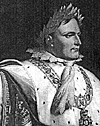 If ever a ruler owed his position to what is called the "will of the people", Napoleon did. Napoleon won it by his success with the sword, not the sword of execution, nor the sword of the guillotine, but the sword of battle against the enemies of France.
If ever a ruler owed his position to what is called the "will of the people", Napoleon did. Napoleon won it by his success with the sword, not the sword of execution, nor the sword of the guillotine, but the sword of battle against the enemies of France.
At right: Napoleon as Emperor at the moment of his corononation, wearing the collar of the Legion of Honour, which he founded in 1802.
The people of France elected Napoleon as the Emperor, because he saved France from its enemies and he defended the gains of the Revolution at home. Napoleon established both the Bank of France and the French bourse (stock exchange) as well as National and Departmental Tax Boards, to insure equitable taxation for all. Consequently, the income of the French peasants skyrocketed.
Napoleon established awards such as the "Legion of Honour" to reward those whose services to the nation merited special recognition; the recipient could be scientist, composer, legislator, clergyman, writer, as well as a soldier.
In the area of public works, over 20,000 miles of imperial and 12,000 miles of regional roads were completed, almost a thousand miles of canals were build, the Great Cornice road was constructed along the Mediterranean coast, mountain roads were constructed across the Alps by ways of Simplon Pass and Mont. Cenis, and harbors were dredged and expanded at many ports, including Dunkerque and Cherbourg.
Not only was Paris beautified with the construction of boulevards, bridges and monuments, but the National Archives received a permanent home. Napoleon also saved the Louvre.
Monument buildings were constructed throughout the Empire and structures, such as the Imperial Cathedral of Speyer, made famous by Luther, were preserved while work on the spires of the great cathedral of Cologne were continued on Napoleon's orders. In fact, Napoleon's architectural handiwork can be found scattered across Europe, from Rome to Vienna.
"Think tanks" and research centers were established in France to work on projects vital for national economy. An Industrial Board was organized to provide data and information to French Industry, as exemplified by the success of the sugar beet farming and the canning industry.
For religion, Napoleon ended the schism and restored the Catholic Church to France by the Concordat in 1801. He insured freedom of religions and equality to the Protestant sects, and he declared France the homeland of the Jews, after it became obvious he could not establish their national home in Palestine.
The Code Napoleon established equality before the law, emphasized the sanctity of the family, and assured the legal gains of the Revolution. The Code of Civil Procedure insured widespread user of mediation in the courts and the laws, and the courts were secularized.
Napoleon created the Imperial University to administer French Education. Specialized engineering and technological schools were established along with the famous lycées to insure a scientific education. The establishment of a Professional School of Midwifery and first School of Obstetrics were formed during the consulate and the School of Veterinary Science was professionalized under Napoleon.
In the military, Napoleon pioneered in what we describe today as the "principles of war" which are studied by almost every military academy in the world. The armies of today are based on the organization created by Napoleon for his Grand Army and it has been used ever since.
Many historians claim that Napoleon created his own legend on St. Helena. The truth is that his legend started in Toulon in 1793. Lord Holland, speaking in the British House of Peers, spoke about the deceased Emperor in August 1833. He stated: "The very people who detested this great man have acknowledged that for 10 centuries there has not appeared upon earth a more extraordinary " character"." This is indeed a tribute to the Emperor.
Back to Assassination of Napoleon
Back to War Lore: The List
Back to Master Magazine List
© Copyright 1999 by Ben Weider.
This article appears in MagWeb (Magazine Web) on the Internet World Wide Web.
Other military history articles and gaming articles are available at http://www.magweb.com